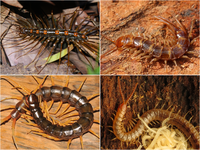
Photo from wikipedia
It has been widely recognized that species show extensive variation in form and function. Based on species' attributes, they can be positioned along major axes of variation, which are often… Click to show full abstract
It has been widely recognized that species show extensive variation in form and function. Based on species' attributes, they can be positioned along major axes of variation, which are often defined by life-history traits, such as number of offspring, age at maturity or generation time. Less emphasis has been given in this respect to tolerance traits, especially to resistance to abiotic stress conditions, which often determine community (dis)assembly and distribution. Soil fauna species distribution is governed to a large extent by environmental conditions that filter communities according to functional traits, such as abiotic stress tolerance, morphology and body size. Trait-based approaches have been successfully used to predict soil biota responses to abiotic stress. It remains unclear, though, how these traits relate to life-history traits that determine individual performance, that is, reproduction and survival. Here, we analyse patterns in multidimensional trait distribution of dominant groups of soil fauna, that is, Isopoda, Gastropoda and Collembola, known to be important to the functioning of ecosystems. We compiled trait information from existing literature, trait databases and supplementary measurements. We looked for common patterns in major axes of trait variation and tested if vertical distribution of species in the soil explained trait variation based on three components of trait diversity (trait richness, evenness and divergence). Our results showed that two to three axes of variation structured the trait space of life-history and tolerance traits in each of the taxonomic groups and that vertical distribution in soil explained the main axis of trait variation. We also found evidence of environmental filtering on soil fauna along the vertical soil distribution, with lower trait richness and trait divergence in soil-dwelling than in surface-living species. Our study was partially limited by the lack of detailed trait measurements for the selected taxonomic groups. In this regard, there is an urgent need for standardized trait databases across invertebrate groups to improve trait-based diversity analysis and fill gaps in the mechanistic understanding behind trait distribution, trait filtering and the link with species fitness and performance.
Journal Title: Journal of Animal Ecology
Year Published: 2018
Link to full text (if available)
Share on Social Media: Sign Up to like & get
recommendations!